Springtime brings renewal and new beginnings to the garden as flowers start blooming everywhere. One fun way to celebrate spring is by growing flowers that begin with the letter “T.”
This diverse group of blooms includes many classic favorites and unique beauties that make for fabulous floral displays. In this article, we’ll explore 40 fantastic “T” flowers.
From rare wildflowers to exotic tropical vines, there’s something for every gardener in this alphabetical lineup. Keep reading to learn about incredible blooms like tulips, tiger lilies, and touch-me-nots that will make your garden the talk of the town this spring!
Annual Flowers that Start with T
Following is the list of Annual flowers that start with T.
Tree Poppy

The tree poppy, with its scientific name Dendromecon rigida, is a flowering shrub native to California and northern Mexico. It gets its common name from its poppy-like flowers and growth habit of up to 13 feet, giving it a tree-like appearance.
The blooms have four bright yellow petals and bloom from March to July. Despite its common name, tree poppy is not closely related to the true poppies.
It prefers dry, rocky slopes and blooms best in full sun. The tree poppy makes an attractive addition to native or drought-tolerant gardens.
Once established, it requires little water or maintenance. Birds enjoy the seeds that follow the flowers.
Torenia
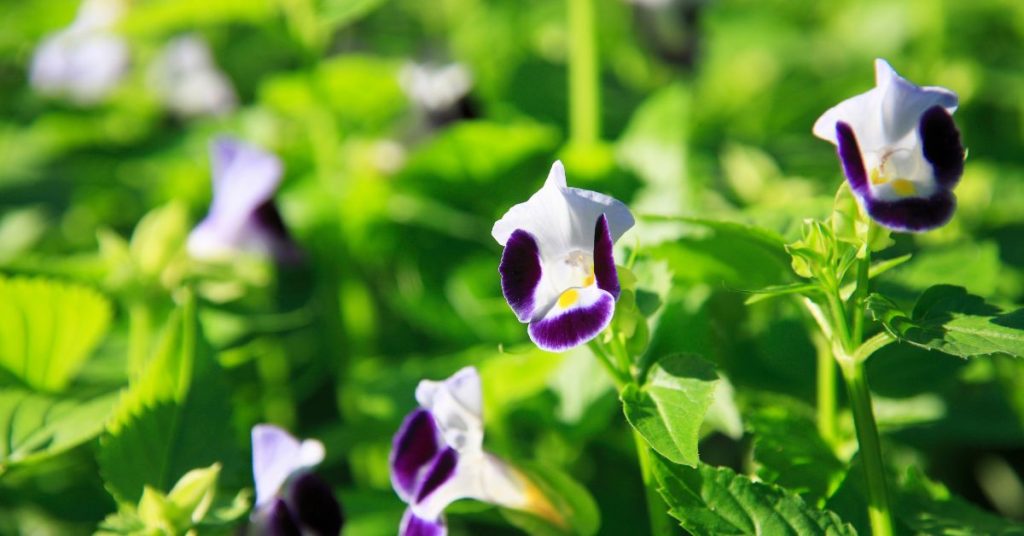
Sometimes called wishbone flower, torenia is a charming annual with distinctive snapdragon-like flowers. Native to tropical Asia, torenia thrives in warm, humid conditions.
The plant grows 8-12 inches tall and spreads 10-12 inches wide. Abundant blooms arise all summer long if spent flowers are deadheaded. The 1-inch blooms come in shades of blue, purple, pink and white with a wishbone-shaped yellow mark in the throat.
Torenia looks lovely in containers or hanging baskets where its trailing habit can be shown off. It also works well in borders and makes an excellent houseplant.
Keep torenia moist and fertilize regularly for nonstop color. It prefers partial shade in hot southern climates. With its profuse blooms and compact size, this heat-loving annual adds vibrant color to any sunny garden space.
Tithonia
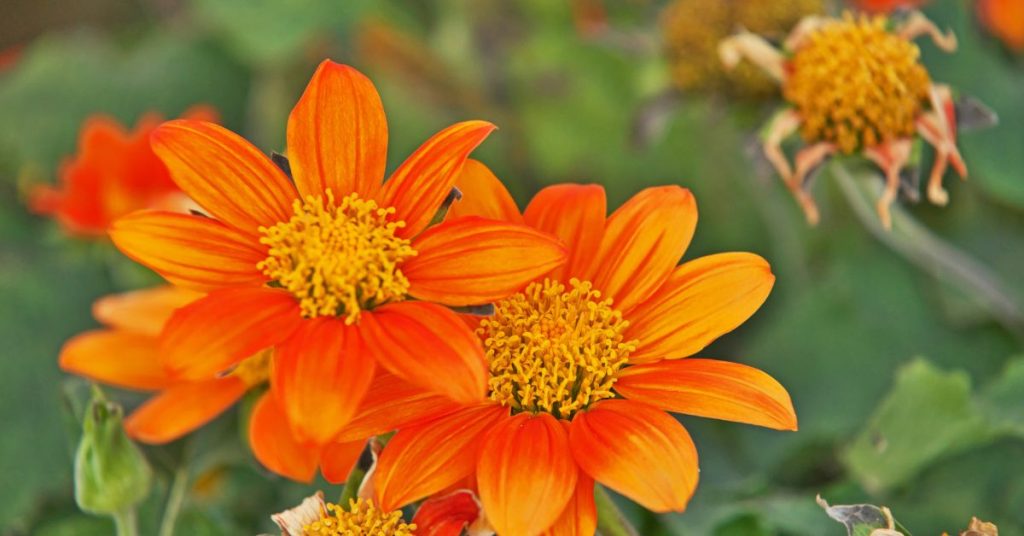
Bold and beautiful, Tithonia, also known as Mexican sunflower, is a stellar addition to any garden looking for towering, tropical flair. Growing 5-6 feet tall, Tithonia produces enormous orange-red blooms reminiscent of daisies or sunflowers.
The large, velvety flowers with yellow centers bloom from mid to late summer on multi-branched, shrub-like plants. Tithonia is easy to grow from seed and germinates readily. It thrives in full sun and moist, well-drained soil.
Deadhead spent flowers to encourage more blooms. Plant en masse along borders or as a backdrop. Tithonia also makes a striking cut flower. Its nectar-rich flowers attract bees, butterflies and hummingbirds.
Native to Mexico and Central America, this heat-loving annual adds vibrant color and drama to any garden it inhabits.
Tree Mallow

Tree mallow, Lavatera trimestris, delivers stunning summertime beauty to gardens and landscapes. This hardy annual grows rapidly, reaching heights of 4-6 feet. From early summer until frost, the showy blooms appear on branching stems above heart-shaped foliage.
Saucer-shaped blossoms 3-4 inches wide come in shades of pink, rose, and white with delicately ruffled petals. After the blooms fade, decorative seed pods add interest.
Tree mallow thrives in full sun and moist, fertile soil. It can tolerate some drought once established. Provide support with stakes or grow tree mallow along a fence.
Use as a background plant, in borders or as part of a cottage garden mix. Tree mallow also works well in large containers. Native to the Mediterranean, this tough plant reliably provides season-long color and height.
Thistle
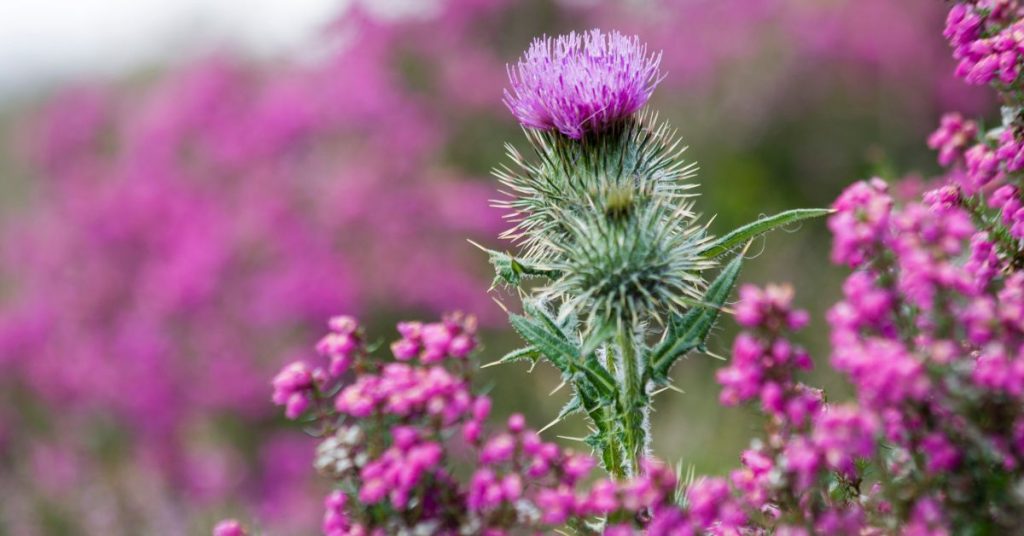
Thistles encompass a variety of flowering plants in the Asteraceae family. Most thistles have sharp prickles on stems and leaves. The flowers can be white, yellow, purple, red, or pink. Blooms consist of tufted, tubular disk florets surrounded by spiny bracts.
Different types of thistles serve as important nectar sources for bees, butterflies, and other pollinators. Some, like the artichoke thistle, have edible flower buds. Others, like milk thistle and blessed thistle, have medicinal uses.
Common nonnative thistles considered invasive weeds in the U.S. include Canada thistle, bull thistle, and Scotch thistle. But native thistles play vital ecological roles in natural habitats.
Thistles grow best in full sun and average to dry soils. While prickly, their unique flowers provide architectural interest to gardens and meadows.
Treasure Flower
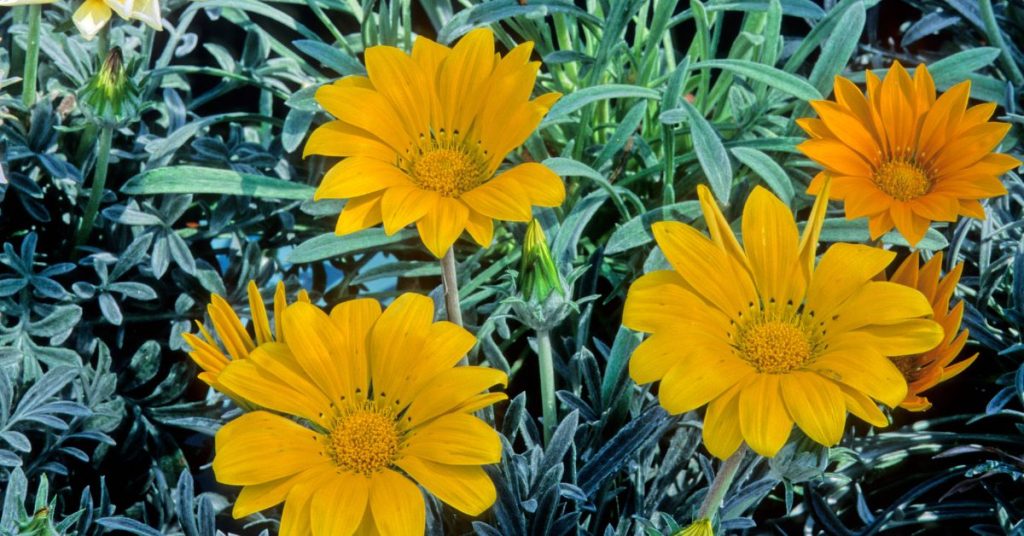
Treasure flower, or Gazania rigens, is a heat-loving perennial grown as an annual in cooler climates. Hailing from South Africa, it thrives in full sun and needs little water once established.
The bright flowers bloom spring through fall in shades of orange, yellow, pink, red and white, sometimes with contrasting rings. Petals radiate from a central brown disk resembling the sun. Treasure flower grows 6-12 inches tall and spreads 1-2 feet.
It works well in rock gardens, borders, containers and hanging baskets, where it cascades beautifully. Deadhead spent blooms to encourage more flowers. Tolerant of sandy, infertile soils, treasure flower needs good drainage.
It attracts butterflies and is deer and rabbit-resistant. With its colorful, daisy-like blooms and easy care nature, this long-blooming beauty is a treasured addition to any sunny garden.
Tagetes
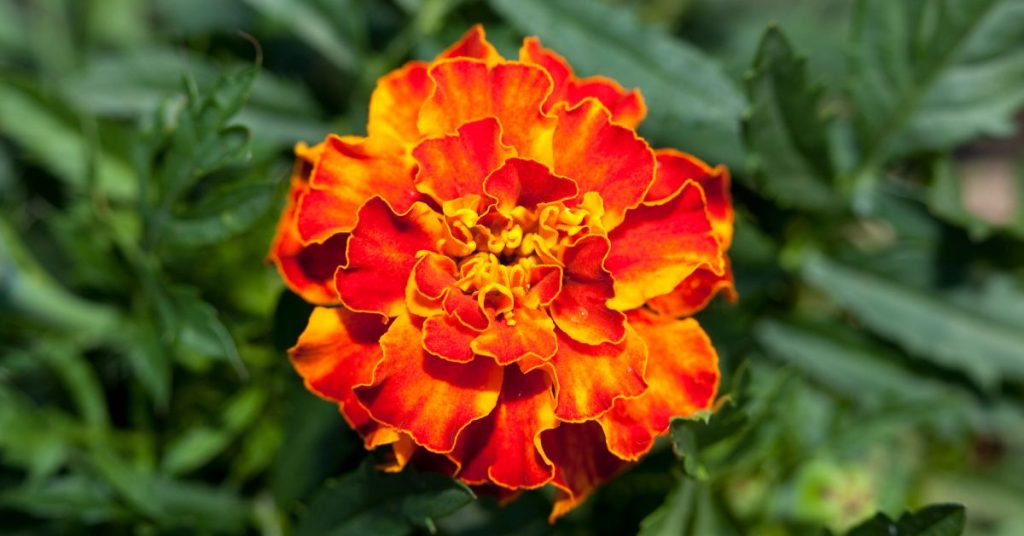
Commonly called marigolds, Tagetes is a diverse genus including over 50 species of annuals, perennials and shrubs. Marigolds are native to the Americas and have naturalized across the world.
The flowers come in a vibrant range of yellows, oranges, reds and bicolors. Bloom shapes vary from tiny buttons to large, crested doubles. Marigolds bring continuous color to borders and beds from spring until frost.
The clumping or mounded plants reach heights of 6 inches to 4 feet depending on variety. Marigolds prefer full sun and well-drained soil. Deadhead spent flowers to encourage new blooms.
Some marigolds like Tagetes erecta and Tagetes patula are edible. Marigolds also have insect repellent properties. Their bright blossoms attract beneficial pollinators.
From petite French marigolds to giant blooms, these cheery annuals are beloved for their diversity and nonstop floral display.
Touch Me Not
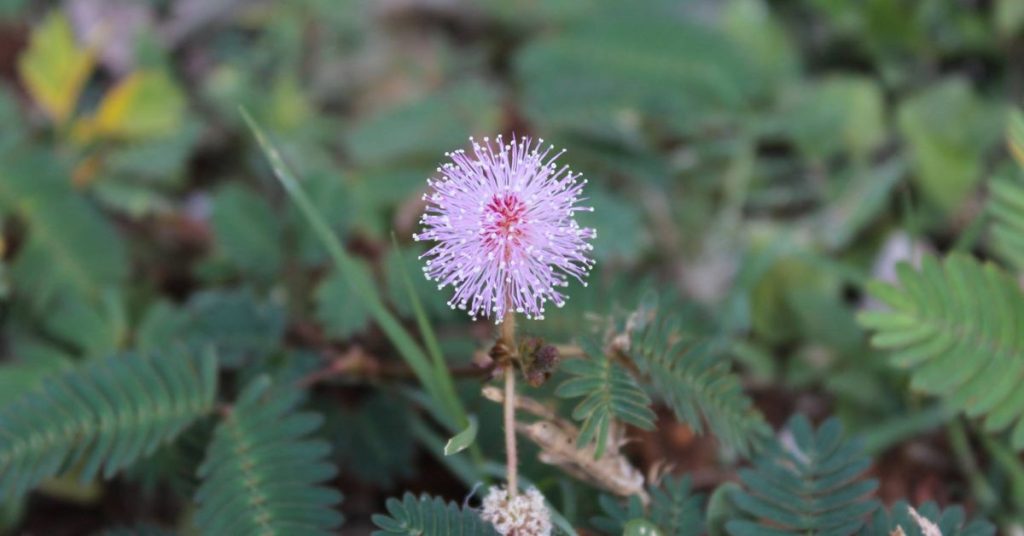
Touch me not, or Impatiens, encompasses over 1,000 species of annuals, perennials and shrubs known for their explosive seed pods. When ripe, the pods burst open when touched, scattering seeds.
The flowers come in a range of colors like white, pink, red, orange, yellow and purple. Many touch me nots thrive in shady areas where few others can grow. They prefer moist soil and bloom from spring to fall.
Common touch me not varieties include busy Lizzie, balsam, polka dot plant, jumping jack and patience plant. Some species grow quite tall, while other cultivars stay under a foot.
Touch me nots add a welcome pop of color to shady beds, borders, containers and hanging baskets. While the lowest maintenance impatiens are annuals, some perennial kinds offer lasting value in the garden. Handle these delicate beauties gently and enjoy their whimsical seed dispersal.
Tuberous Begonia
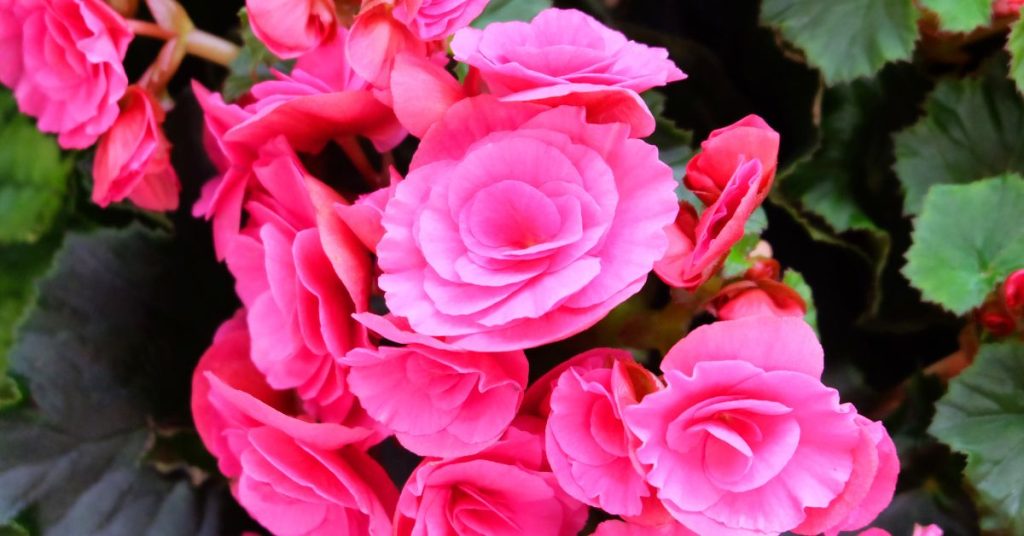
For fantastic flowers from spring until frost, look no further than tuberous begonia. Grown for their oversized, showy blooms and attractive foliage, tuberous begonias thrive as potted plants or bedding annuals.
Multiple kinds exist, from upright types to trailing and dwarf varieties under 1 foot tall. The extravagant double blossoms can be rose-like or camellia-form, reaching 3-5 inches across.
Popular colors include red, pink, orange, yellow, white and salmon. Tuberous begonias grow from tubers, not seeds, with the tubers available each spring. Provide rich, moist soil and partial shade. Pinch back leggy growth to encourage bushiness.
Check tubers after first frost and store in cool, dry conditions over winter. With their tropical beauty and nonstop flowers, it’s no wonder tuberous begonias remain garden classics.
Perennial Flowers that Start with T
Following is the list of Perennial flowers that start with T.
Tulip
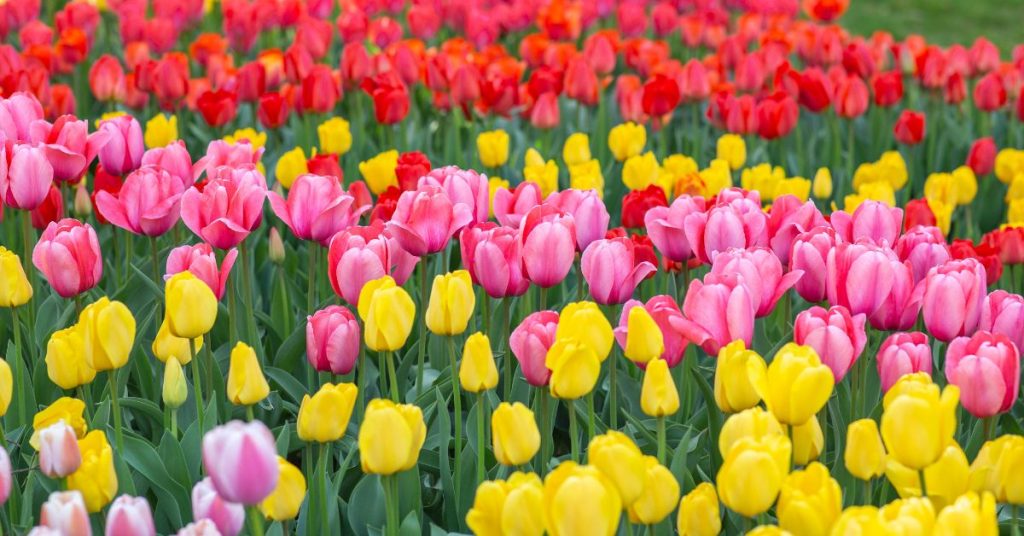
Featuring showy, cup-shaped blooms on long upright stems, tulips reign as one of the most popular spring flowering bulbs. They come in practically every color except blue: vivid reds, sunny yellows, luminous whites, pretty pinks, deep purples, striking bicolors and more.
Flower forms range from elegant and understated to ruffly, double blooms. Tulips bloom April to May depending on type and climate. After flowering, the foliage sticks around to replenish the bulb for next year’s display.
Plant tulip bulbs in fall at a depth of 8 inches in a sunny spot with good drainage. To enjoy these spring ephemerals longer, choose types that bloom at different times or plant annuals between. Nothing announces the arrival of spring like a burst of colorful tulips!
Tall Bearded Iris

With impressive, ruffled blooms in a rainbow of hues, it’s easy to see why tall bearded iris are garden classics. Native across temperate regions, these hardy perennials showcase great diversity. The upright plants reach 2-3 feet tall on average.
The signature bearded bloom displays three drooping petals, or falls, and three upright standards. Prolific flowering occurs May to June and again in summer. Tall bearded iris come in every color except true red: purple, blue, pink, orange, yellow, white, black, peach, wine, and multicolor.
They thrive in full sun and average garden soil with good drainage. Avoid overcrowding and divide clumps every few years.
Use behind smaller plants in perennial borders or mass for dramatic impact. Tall bearded iris have sparked fascination for centuries with their stately elegance and rainbow palette.
Tiger Lily
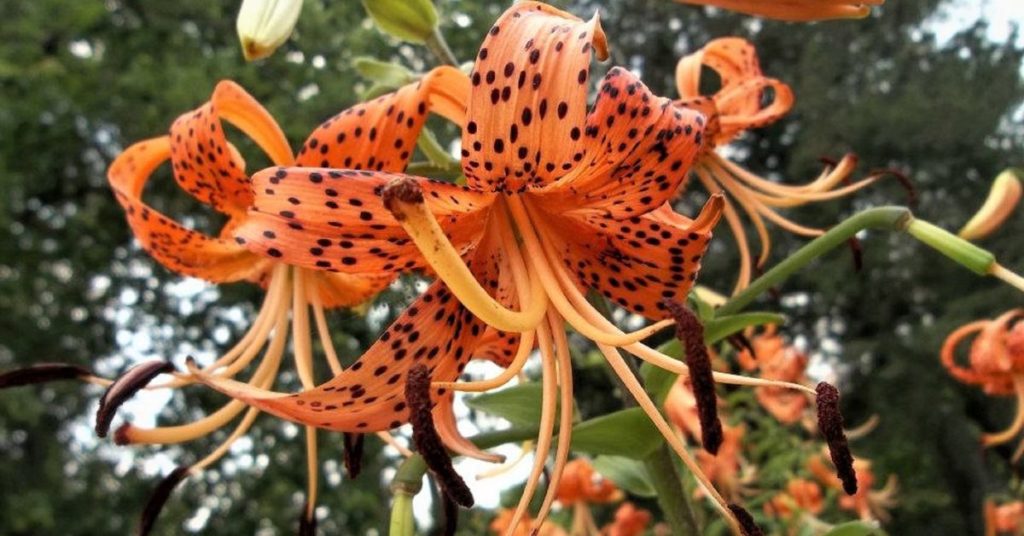
Add drama, height and vibrant color to your garden with tiger lily. This hardy perennial grows from a bulb to a height of 4-6 feet tall. The botanical name Lilium lancifolium hints at the lance-shaped leaves that provide an attractive backdrop to the flower stalks.
Big, showy blooms feature recurved petals spotted and streaked with dark freckles, living up to the name tiger lily. The orange flowers appear in mid to late summer.
Grow in full sun or partial shade and fertile, well-drained soil. Plant the bulbs in fall at a depth 2-3 times their size. Stake tall stems if needed.
Tiger lily works well in perennial beds, borders, wild gardens or fresh-cut bouquets where it really shows off!
Turtlehead

Turtlehead perfectly captures the whimsical spirit of late summer with its unique blooms. This North American native perennial grows 2-4 feet tall on upright clumping stems.
The unusual flowers resemble turtle heads or snapdragons, giving it the common names turtlehead and shellflower. Blooms appear August to September in white, pink, or rose and attract bees, butterflies and hummingbirds.
The long-blooming, shade tolerant turtlehead thrives in moist soils and boggy areas. Use it along streams, ponds or in rain gardens. Mass in borders and woodland gardens or mix with ferns and asters.
Chelone glabra and Chelone obliqua are two commonly grown species. With strange billowy blooms on tall stalks, turtlehead adds distinctive charm to shady spaces.
Tweedia
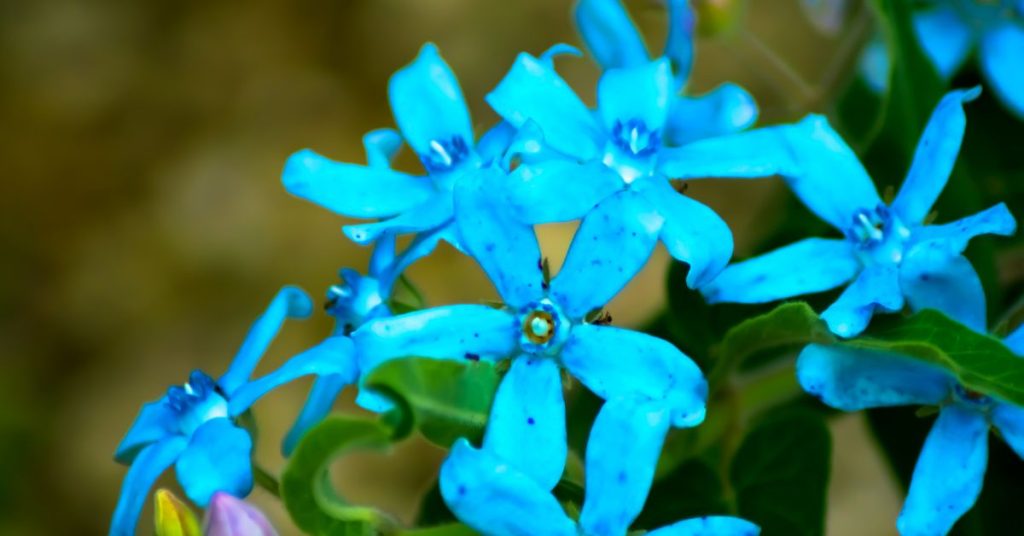
Looking for a star-studded addition to your garden? Tweedia offers glowing floral beauty on trailing stems perfect for hanging baskets, borders, and beds. Also known as blue-eyed Susan, this South American native works well as an annual or short-lived perennial in suitable climates.
Tweedia produces an abundance of sky blue, daisy-like flowers with yellow centers continuously from early summer until frost. Mature size reaches up to 2 feet tall and wide but the plant sprawls and trails gracefully.
Grow in full sun with moist but well-drained soil. Fertilize regularly for the best flower production. Tweedia looks lovely mingling with other trailing annuals and perennials.
Use it to soften edges of raised beds or in containers and window boxes. This vibrant plant will leave you starry-eyed in the garden!
Thimbleweed
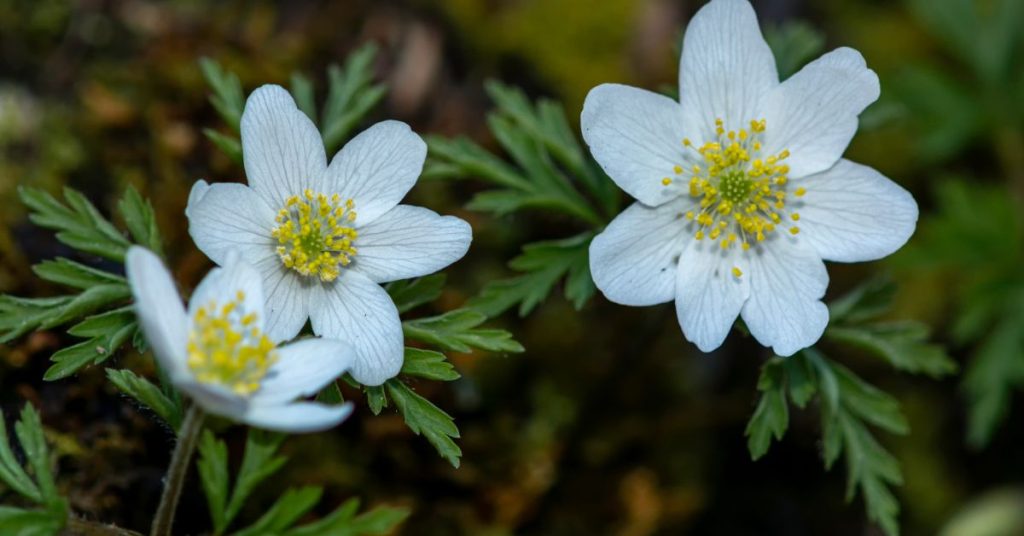
Sporting unique, thimble-shaped seed heads, Anemone virginiana goes by the common name thimbleweed. This herbaceous perennial native across eastern North America grows 1-2 feet tall.
Soft textured foliage emerges early in spring, followed by showy white flowers in late summer. The flowers consist of five petal-like sepals and yellow centers. As the seed head forms in fall, the feathery tails spread out resembling sewing thimbles.
Thimbleweed thrives in dappled shade with consistent moisture. An excellent pollinator plant, it attracts bees, butterflies and wasps. Use thimbleweed to emulate native woodland habitats. The unusual seed heads provide visual interest into winter.
Combine with ferns, wild geranium and asters for natural appeal in informal, shady gardens.
Texas Mountain Laurel

Texas mountain laurel dazzles southern gardens with vivid purple blooms and evergreen foliage. This small tree or large shrub bears aromatic, pea-like flowers each spring. The blossoms give way to curious bean pods.
Easy to grow in USDA zones 8-10, Texas mountain laurel thrives in full sun or partial shade and needs little water once established. It requires good drainage and may drop leaves if overwatered.
Ranging 7-10 feet tall, Texas mountain laurel works well as a specimen plant or clustered in groups. It also makes an attractive, drought-resistant hedge. Take care when handling, as the leaves may irritate skin.
While slow growing, this durable plant lives up to 100 years. Texas mountain laurel delivers year-round interest along with its striking spring display.
Transvaal Daisy
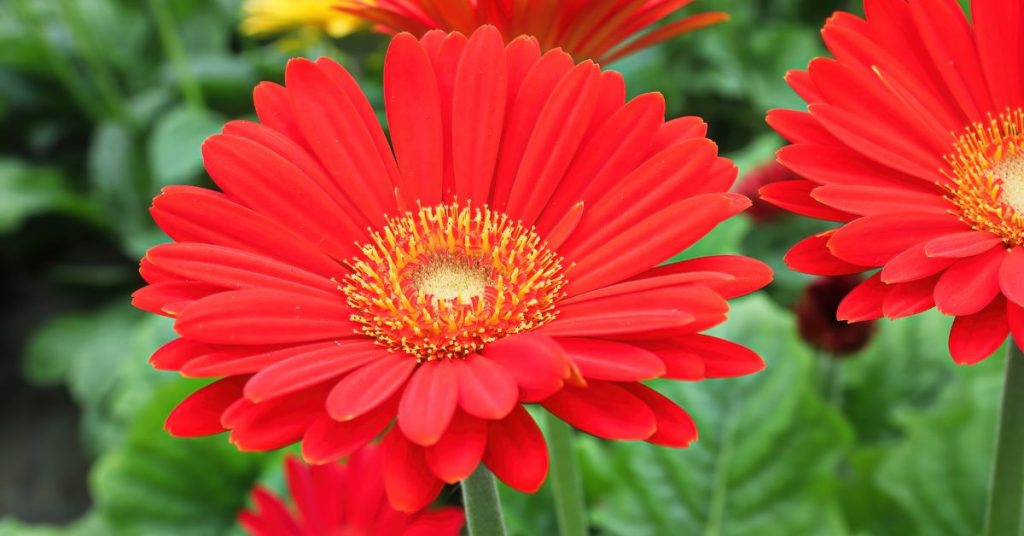
Hailing from South Africa, Transvaal daisy offers fabulous color impact through hot summers. This compact perennial reaches only 8-12 inches tall but spreads 12-24 inches wide.
From spring until frost, it produces a profusion of bright, daisy-like blooms in shades of white, pink, salmon and red. The flowers open fully in morning sun and close at night.
Transvaal daisy thrives in full sun with well-drained soil. It tolerates heat, humidity and drought extremely well. Use this tough, petite plant at the front of borders or in rock gardens.
Transvaal daisy also shines in containers and hanging baskets. Where hardy, it may overwinter as an evergreen perennial. Transvaal daisy provides big flower power on dwarf plants with its long season of vibrant color.
Trumpet Vine
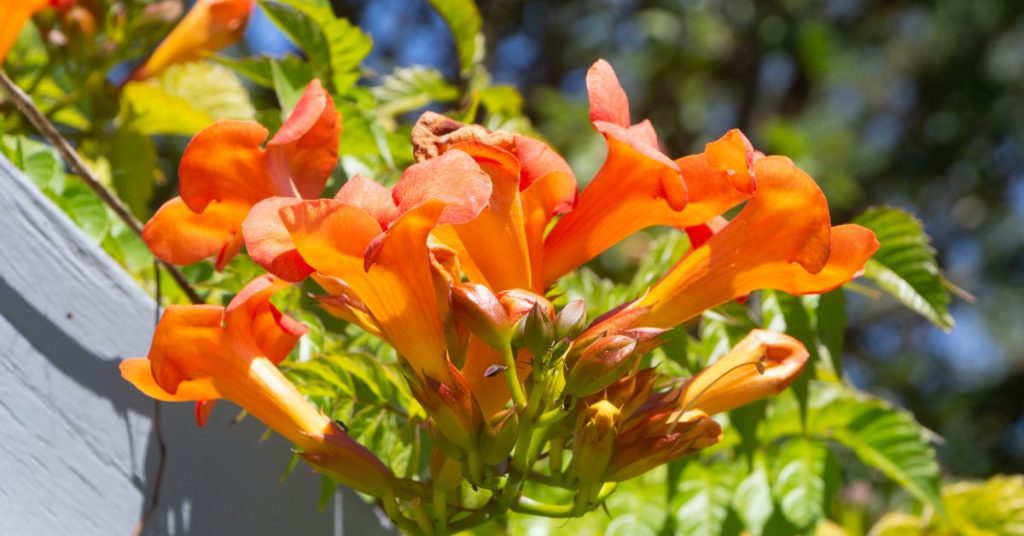
Trumpet vine dazzles with its drooping clusters of tubular, trumpet-shaped orange to red blooms. A woody vine requires sturdy support from arbors, trellises and structures it can climb.
Trumpet vine grows up to 40 feet in length at a vigorous pace. The flowers appear summer into fall and attract hummingbirds. The dark green leaves provide a nice, dense cover.
Two popular species include Trumpet Creeper (Campsis radicans) and Chinese trumpet vine (C. grandiflora). Both require full sun but adapt to various soils. Trumpet vine also has attractive fall color.
While it can be invasive, keeping it in check is easy with pruning. For fast-growing drama on fences or arbors, few vines can rival the showy display of trumpet vine!
Trollius
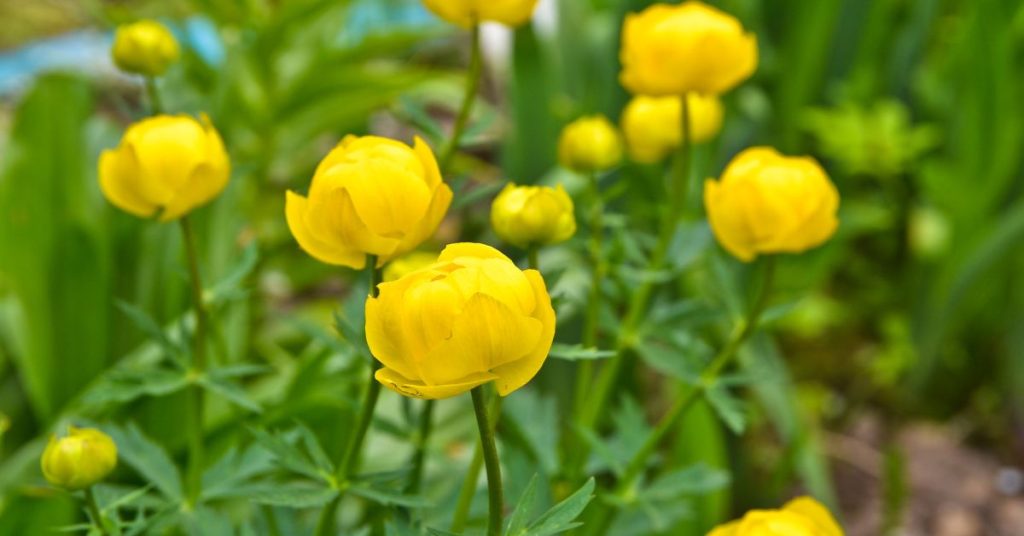
Trollius offers delightful globes of bright blossoms and attractive lobed foliage. Commonly called globeflower, it provides a cheery pop of color to late spring and early summer gardens.
The perennial flowers feature tightly packed, rounded clusters of yellow, orange or creamy white petals. Blooms sit like colorful spheres above the healthy green foliage. Trollius grows 1-3 feet tall in clumps and spreads 1-2 feet wide.
It prefers full sun to part shade and consistently moist soil rich in organic matter. Use trollius as an edging plant, in wildflower meadows or mixed containers.
Butterflies flock to the nectar-rich flowers. Though short-lived, trollius readily self-seeds so you can enjoy years of globular floral beauty.
Tall Kangaroo Paw

Reaching heights of 4-6 feet, tall kangaroo paw makes a dramatic architectural statement wherever it grows. This Australian native perennial showcases unique fuzzy blooms that sway delicately in the breeze.
Tall kangaroo paw thrives in full sun and sandy, well-drained soil. It needs very little water once established then blooms over a long season from early summer until fall.
The tubular flowers emerge in shades of red, green, gold, orange, yellow and pink. Hummingbirds frequent these nectar-rich blooms. Use tall kangaroo paw as a focal point, edging plant or in mass plantings for big impact.
It pairs beautifully with grasses and other waterwise plants. For an exotic, sculptural look, tall kangaroo paw delivers all season long.
Trumpet Creeper

Trumpet creeper vine charms with its hanging clusters of brightly colored, trumpet-shaped flowers. Vigorous and fast growing, this woody vine reaches lengths of 25-50 feet.
It features green, multi-branched stems sporting showy blooms in summer and fall. Flower color ranges from brilliant orange to golden yellow to scarlet red, attracting hummingbirds in droves.
Trumpet creeper, also called cow itch vine, needs sturdy structures for support and full sun. Though it climbs by tendrils, mature vines have adhesive holdfasts that help cling to surfaces.
While aggressive, pruning keeps trumpet creeper in bounds. Both native and Asian species exist. Wherever it grows, trumpet creeper vine brings season-long drama with its cascade of vibrant, dangling flutes.
Toadflax

Toadflax comprises a genus of around 35 species of herbaceous perennials. Flowers have two lips, similar to snapdragons. Blooms come in shades of purple, yellow, pink, rose, peach, or white from late spring through fall. Foliage is long and narrow.
Toadflax thrives in sunny fields and roadsides, tolerating poor soil. They attract bees, butterflies and hummingbirds. Well-behaved kinds work well in borders, rock gardens and wildflower meadows.
However, some species like Dalmatian toadflax behave invasively outside their native range. With snapdragon-shaped flowers on slender wiry stems, toadflax plants add delicate vertical interest and charm to gardens.
Popular varieties include Alpine toadflax, blue toadflax, blue snapdragon and elegant yellow toadflax. Grown among grasses or other meadow plants, toadflax showcases airy, elegant beauty through the seasons.
Tartarian Aster
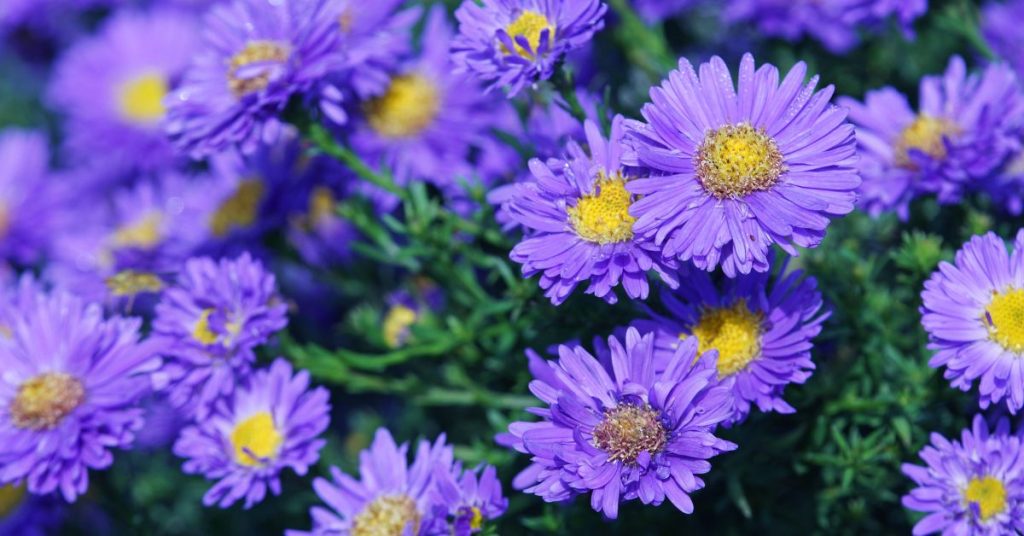
Delivering a kaleidoscope of fall color, Aster tataricus earns its common name tartarian aster. This upright perennial grows 3-5 feet tall on leafy, branched stems. Easy to grow, it thrives in full sun or partial shade and moist fertile soil.
In late summer through fall, tartarian aster explodes into bloom with a diverse mix of pretty star-shaped flowers. Colors include rich purples, dusky pinks, light blues and creamy whites.
Use tartarian aster in borders, wildflower meadows, rain gardens and along ponds. Its towering height provides background, while the flowers attract bees and butterflies.
Smaller species like Italian aster make great companions. Let tartarian aster light up your landscape with strobe-like color through the autumn months.
Tea Rose

Beloved for their nostalgic, old-fashioned fragrance and lush blooms, tea roses shine in cottage gardens. Modern hybrids display incredible diversity in size, growth habit and flower form.
Bushy shrubs reach 2-4 feet tall, while climbing varieties extend 10 feet or more. Bloom colors span the palette: rich reds, soft pinks, sunny yellows, pure whites.
Many have a strong, spice-rose scent. Tea roses flower repeatedly from spring to fall in mild climates. Provide at least 6 hours of direct sun, fertile soil and good air circulation.
Prune in winter or early spring. Watch for diseases like powdery mildew and rust. With timeless elegance and intoxicating fragrance, tea roses are the quintessential flowering shrub for romantic gardens.
Twinspur

Offering a sweet treat for shade gardens, twinspur charms with its delicate, paired blooms. This rhizomatous North American native perennial reaches 1-2 feet tall.
In early spring, bell-shaped flowers dangle sweetly in white, pink or red pairs above the foliage. The fern-like leaves have 3 leaflets giving twinspur its genus name Diascia, meaning twin.
Hummingbirds frequent the nectar-filled blooms. After flowering, fruit capsules appear containing small shiny black seeds.
Twinspur thrives in moist, well-drained soils and bright to medium shade. Use it alongside ferns, hostas, hellebores or astilbes for natural appeal. For an adorable woodland accent, the darling twin bells of twinspur are just the ticket.
Trachelium

Sometimes called throatwort, trachelium bears clusters of pretty flowers perfect for cutting. This herbaceous perennial grows 2-3 feet tall on upright, sturdy stems. Blooms resemble small purple, blue or white lilies.
Flowering lasts throughout summer with deadheading. Trachelium does best in full sun to part shade and average garden soils with good drainage. Use trachelium towards the back of flower beds and borders.
Combine it with coneflowers, rudbeckia, phlox and asters. The elegant flower spires also make exceptional cut flowers and dry nicely. Trachelium caeruleum is the most commonly grown species.
With long-lasting color and versatile uses, this charming perennial deserves a spot in sunny flower gardens.
Thunbergia grandiflora

A fast-growing vine native to India, Thunbergia grandiflora boasts vibrant flowers sure to make a big impact. It’s commonly called Bengal clockvine or blue trumpet vine.
Showy blossoms resemble curving tubular trumpets in shades of bright blue or purple, sometimes with a white throat. The flowers appear summer to fall against lush green foliage.
This twining vine can reach up to 15 feet long. Grow Thunbergia in full sun to part shade and fertile soil with good drainage. It requires regular watering and a strong trellis or support for optimal growth.
Use Bengal clockvine to add height and pop of color to fences, arbors, and porch railings. Where not winter hardy, grow as an annual. The exotic tropical blooms of Thunbergia will enthrall your landscape.
Triplet lily

Showcasing three flowers per stem, triplet lily lives up to its name with charming floral arrangements. This hardy perennial grows from bulbs to a height of 1-2 feet tall.
Slender leaves give way to upright stalks, each topped with three downward facing, recurved blooms. Flower color ranges from glistening white to shades of pink and rose. Inside each blossom is a deep red throat.
Triplet lily blooms in late spring to early summer, thriving in light shade and moist, well-drained soil. Plant the bulbs 4 inches deep in fall. Triplet lily shines along woodland paths and walkways.
Use it to brighten shaded garden beds and borders. Unique and easy to grow, this lily will triple your floral pleasure.
Tansy
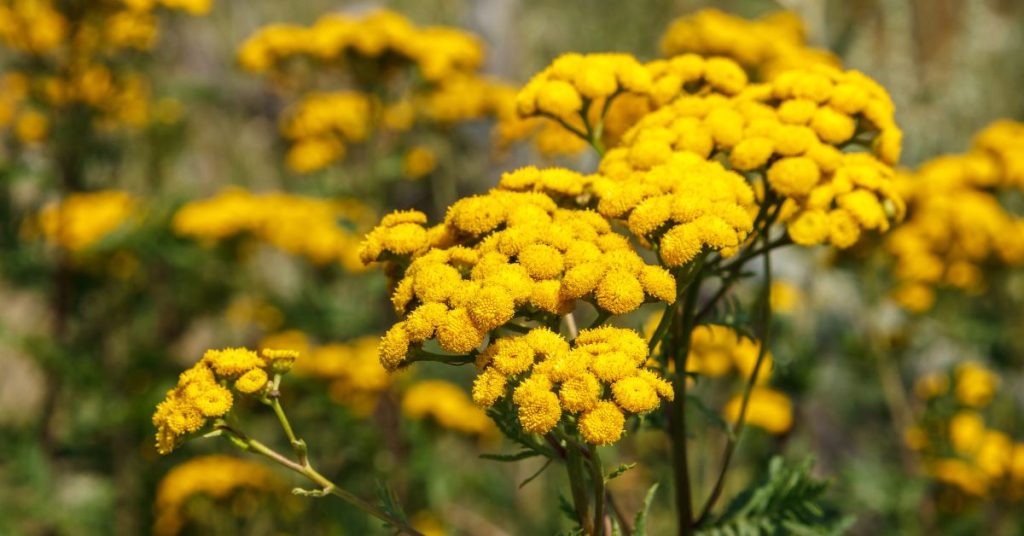
With fern-like foliage and vibrant yellow button flowers, tansy adds cheerful color to gardens and landscapes. This perennial herb grows 2-4 feet tall in a spread of 1-3 feet wide. Tansy thrives in full sun and average to dry soils.
It will tolerate some shade but flowers best with plenty of light. The round golden composite blooms appear in clusters late spring to summer and make nice cut flowers.
Ferny aromatic leaves remain evergreen in mild winter climates. Tansy spreads by rhizomes and self-seeds readily. It works well in perennial beds, meadow gardens, and for erosion control.
Just beware, common tansy can become invasive. But where kept in check, this robust herb infuses gardens with golden hues and delicate texture.
Tetraploid Daylily
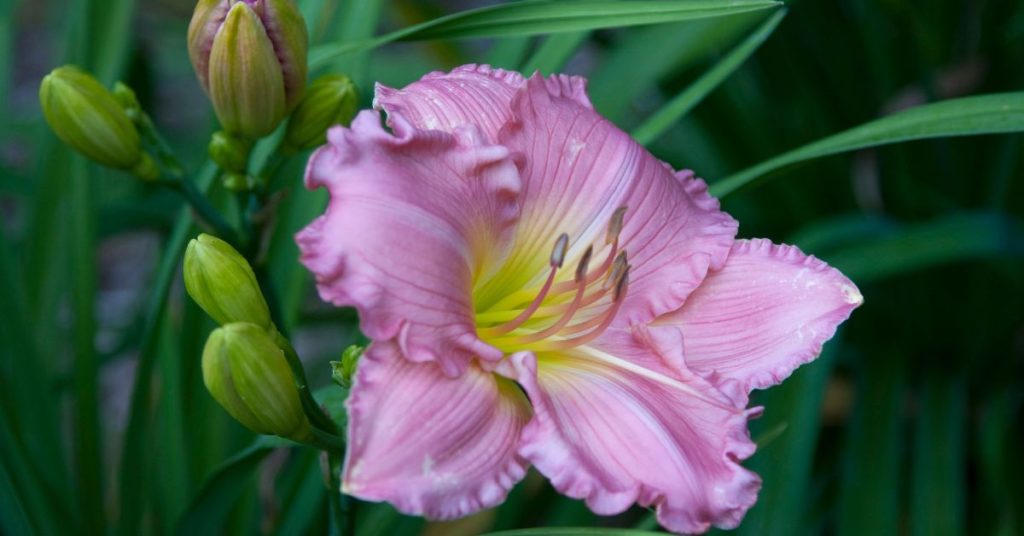
For supremely large and sumptuous blooms, turn to the tetraploid daylily. These modern hybrids showcase double the normal number of chromosomes, creating huge 6 to 8-inch flowers.
Tetraploid daylilies grow in all the same colors as diploid varieties: red, purple, pink, orange, yellow, peach, cream and more. The plants reach 2-3 feet tall in clumps of grassy foliage. They bloom mainly in summer and feature rugged adaptability and vigor.
Provide full sun and well-drained soil. Use tetraploid daylilies as focal points or edging plants in perennial beds and borders.
Bred for their massive, exotic blooms, these floral heavyweights offer a super-saturated daylily experience for the landscape.
Toad lily
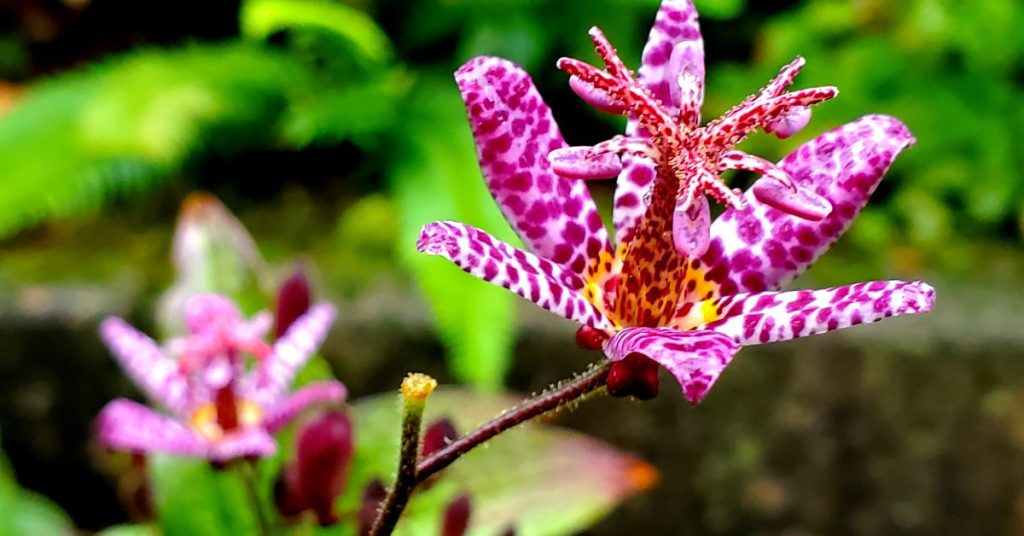
With exotic, orchid-like blooms, toad lily proves that beauty need not be commonplace. This late summer flowering perennial hails from China and Japan. Toad lily grows 2 feet tall and wide, with lance-shaped leaves giving rise to dainty hooded flowers.
Splashed with purple spots and speckles, the blooms come in shades of pink, lavender, and white. Flowering occurs in shade, followed by attractive seed pods.
Toad lily thrives in moist, rich soil and bright to full shade. Use it alongside hostas, astilbes, and other shade lovers. The species Tricyrtis hirta is very hardy.
Toad lily offers a choice specimen plant with its otherworldly flowers and graceful Asian elegance.
Trillium
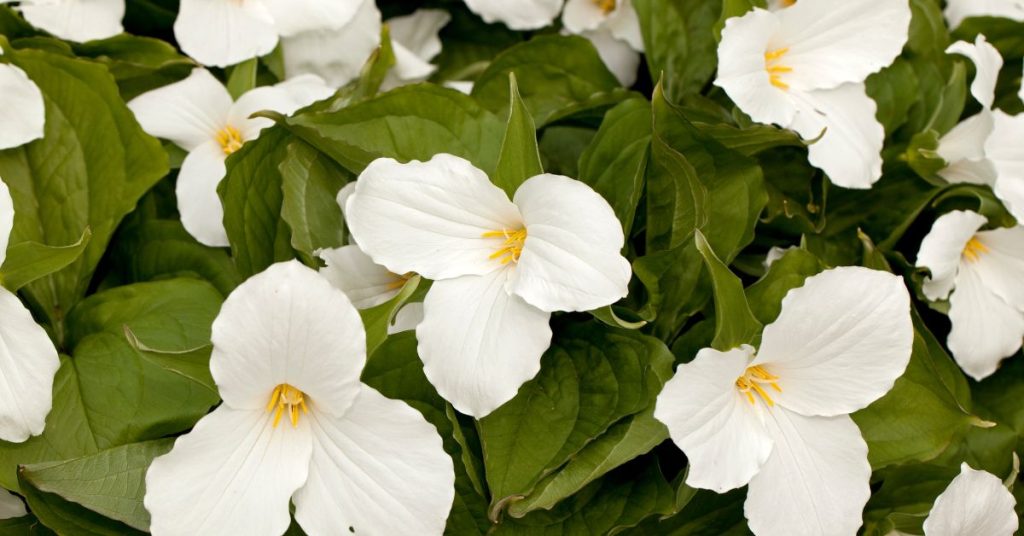
Carpeting forest floors each spring with starry white flowers, trillium delivers graceful natural beauty. These native North American woodland wildflowers thrive in moist, acidic soils and dappled shade.
Trillium spreads slowly via rhizomes into large drifts over time. Blooms feature three white petals and foliage in groups of three. Popular species include snow trillium, wake robin, and painted trillium with red accents.
Trillium looks lovely under trees, along shady paths and walkways or tucked amid shrubs. Bumblebees frequently pollinate the flowers.
Though short-lived, trillium self-seeds once established in suitable habitat. For whimsical white carpets celebrating spring, trillium is a woodland treasure.
Tree Peony

Tree peonies reign majestically in the garden with their enormous, sumptuous blooms in shades of white, pink, red and purple. These woody shrubs showcase flowers up to 10 inches across!
Tree peonies grow 4 to 5 feet tall, forming a shapely rounded habit. Blooms arise on the bare branches in late spring, followed by attractive lobed foliage.
Tree peonies thrive with full sun or minimal shade and neutral to slightly alkaline soil. Avoid disturbing the large root systems once planted.
Most tree peonies take 3 to 7 years before flowering. But once mature, they reward gardeners with a grand floral display year after year for decades to come.
Tall Verbena
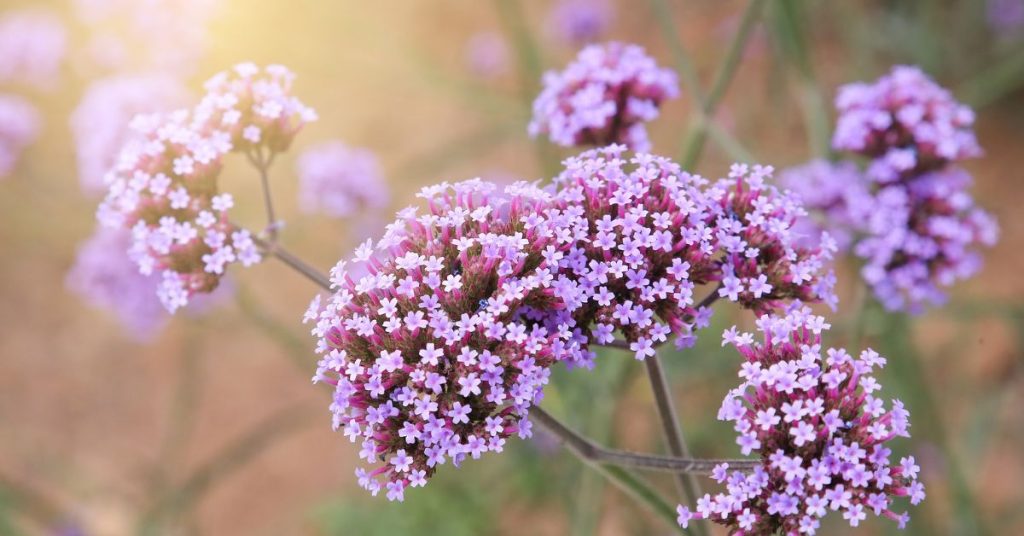
Reaching 4-6 feet tall, Verbena bonariensis provides lofty color from summer into fall. This perennial verbena bursts forth in clusters of tiny purple-blue flowers attractive to butterflies and bees. The wiry, stiff stems shoot upward like purple fountains.
Tall verbena thrives in full sun and tolerates drought, humidity, and poor soil quite well. Use it in cottage gardens, meadows, prairie-style plantings or coastal areas.
Tall verbena self sows freely, weaving airily through other plants. For drama in borders or as a see-through, butterfly-friendly hedge, this tough plant delivers.
Cut back hard after flowering to encourage fresh growth. With its architectural elegance and carefree nature, tall verbena stands out among the best butterfly plants.
Thyme
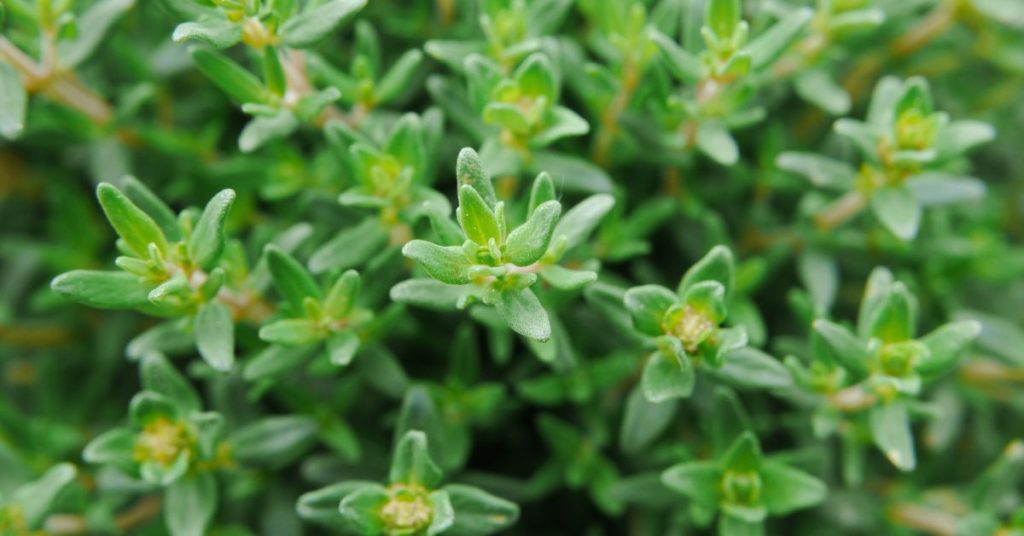
A staple herb in home gardens, thyme offers yet another reason to love this adaptable, aromatic plant – its flowers! Varieties of thyme produce small but abundant blooms in shades of purple, pink or white.
The flowers appear on short upright stems over tiny fragrant leaves in summer, attracting bees and butterflies. Some thyme selections are primarily grown for their ornamental appeal, like creeping thyme used as a groundcover.
Give thyme full sun and well-drained soil. Trim it back after flowering to maintain shape. Thyme combines beautifully with ornamental grasses and other herbs like rosemary and lavender.
Let thyme infuse your garden with scenic flowers and intoxicating fragrance.
Tennessee Coneflower
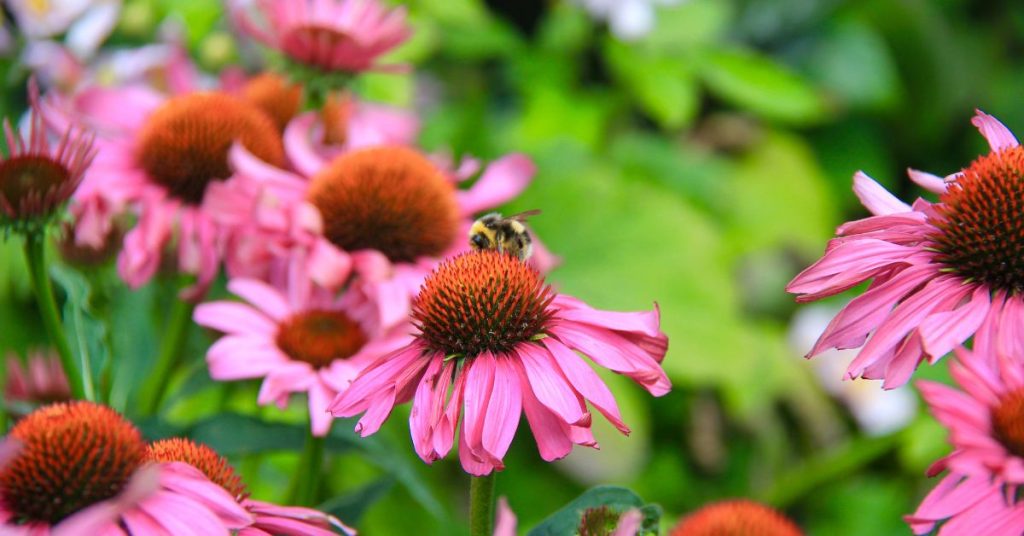
Showing off the colors of fall, Echinacea tennesseensis brightens gardens with its unique sunset hues. This native coneflower inhabits woods and prairies across much of the Eastern U.S. Growing 3-4 feet tall, the branched stems carry daisy-like flowers with swept-back petals.
The orange-red to deep rose petals and brown centers did inspire the common name. Tennessee coneflower blooms mid to late summer. It thrives in full sun and moist, well-drained soil.
Use it in native plant gardens, prairie landscapes, wildflower meadows and open woodland settings. Butterflies and bees flock to the blossoms.
Distinctly colored and carefree, Tennessee coneflower brings the spirit of autumn to perennial plantings.
Toyon Shrub

Adding bright color to western gardens, Heteromeles arbutifolia offers seasonal beauty as both shrub and tree. Toyon provides profuse clusters of white blossoms, dark green foliage, red berries and outstanding fall color.
The adaptable, drought tolerant plant reaches 15 feet tall and wide, with an open, arching form. It thrives in sun or light shade and nearly any well-drained soil.
Toyon flowers attract bees while birds relish the colorful berries of fall. Use it as a specimen plant or informal hedge. Toyon works nicely in California native landscapes, Mediterranean gardens or xeriscapes.
Adaptable and carefree, this four-season shrub brings year-round magic to western gardens.
Tickseed

Tickseed offers cheerful floral color from spring until frost from an easy, compact plant. These hardy North American wildflowers belong to the Coreopsis genus. Growing 1-2 feet tall on thin, wiry stems, tickseed blooms in sunny yellows, oranges and reds with darker centers.
Daisy-like flowers have petals in two distinct groups, making them easy to recognize. Tickseed thrives in full sun with average, well-drained soil.
Use them in beds, borders, rock gardens and meadows. Deadhead spent blooms to promote more flowering.
Popular varieties include early sunflower, moonbeam coreopsis and threadleaf coreopsis. Where happy, tickseed readily self-sows, giving you ample flowers for seasons to come.
Trailing Arbutus
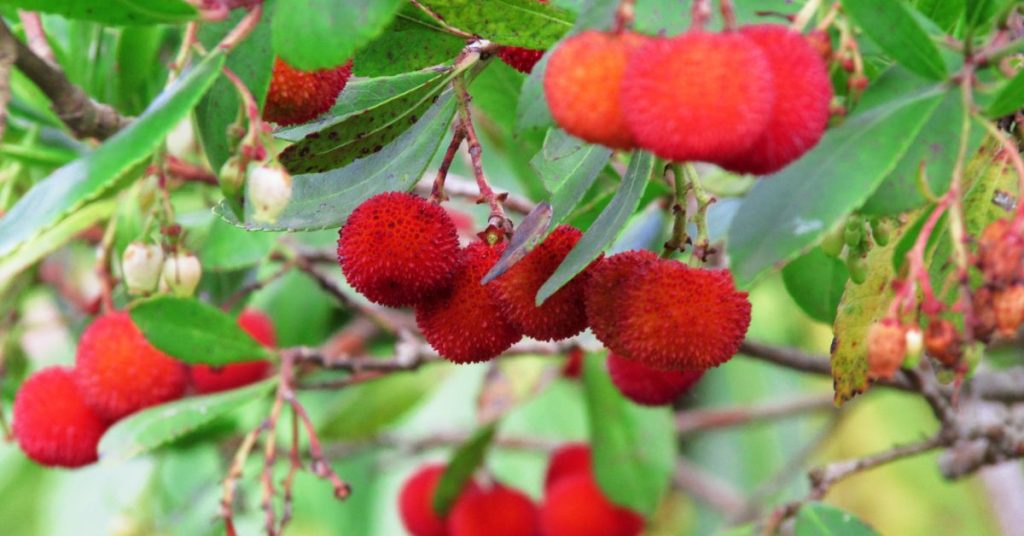
With shell-pink, fragrant flowers carpeting wooded areas each spring, trailing arbutus announces warmer weather is on the way. This beloved wildflower is also called mayflower.
Trailing arbutus is a creeping evergreen perennial, forming mats only a few inches tall. The attractive white, pink or rosy red blooms appear from March through May, providing a delicate floral treat underneath leaf litter and snow.
Glossy dark green, oval leaves persist over winter. Give trailing arbutus well-drained acidic soil and partial shade to emulate its native habitat.
Grow it under trees, along woodland paths or rock garden edges. Hard to cultivate but perfect for natural plantings, trailing arbutus remains a poetic floral gem of early spring.
You May Also Like:
- Flowers that start with U
- Flowers that start with V
- Flowers that start with W
- Flowers that start with X
